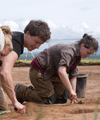August
Excavation sheds new light on Roman life in northern England

The Maryport excavation site has once again yielded new information about life on the Roman frontier in the north of England.
This is the second year a team of Newcastle University archaeologists and volunteers led by project director Professor Ian Haynes with site director Tony Wilmott has made discoveries which challenge and inform archaeological theories held worldwide.
??Bone fragments, caps of tooth enamel, a glass bead necklace and a tiny fragment of ancient textile have been found in newly discovered early Christian graves. Other finds include carved Roman stone work and the first complete altar stone to be unearthed at the site since 1870 when the internationally famous cache of 17 was discovered by landowner and antiquarian Humphrey Senhouse and his team.
Professor Ian Haynes said: "This has been a tremendously fruitful season the highlights of which will keep archaeologists talking for many a year. ??
"We have recovered the plans of the buildings on the site and they show at least two phases of construction. We found some of the foundations in last year’s dig when we disproved the theory that the 17 altar stones had been carefully buried as part of a ritual and had instead been used as ballast.??
"The cemetery appears to have been in use at the same time as other famous early Christian sites at Whithorn and at Hoddom in nearby Dumfriesshire, and would probably have been used between the fifth and seventh centuries AD. We await the results of radiocarbon dating eagerly in the hope of getting a more precise fix on the period of use.??
"The altar found this year had also been used as ballast to support the walls of a huge timber building in use in the decades following Roman rule in Britain.
??"The altar itself is a wonderful find, the fifth inscription to be recovered in the Roman empire to record T. Attius Tutor, commander of the Maryport garrison, and a man known to have served at other times in Austria, Hungary and Romania."
??Tony Wilmott, site director said: "The bone and textile samples will be sent to archaeological laboratories for carbon dating and we hope to have the results in early 2013.??
"The glass necklace and loose beads will be conserved for display in the Senhouse Roman Museum later this year." ??
Peter Greggains of the Senhouse Museum Trust said: "The extraordinary success of this year's work is well-deserved.
??"We are lucky to have found such a great team of archaeologists, students and volunteers, ably led by Ian and Tony, and look forward to supporting their work at Maryport during the next three years." ??
Nigel Mills, director of world heritage and access for the Hadrian's Wall Trust said: "This year's finds at Maryport are of tremendous significance. They contribute to the growing body of evidence from across Hadrian’s Wall from sites such as Birdoswald and Vindolanda that occupation continued through the fifth and sixth centuries.??
"The end of Roman imperial administration did not mean that everything came to a stop and the country descended into chaos. Administration became more localised and people had to fend for themselves but the natural tendency would have been to keep things going as best they could.??
"Christian religion may have been an important element helping to bind society together in troubled times. The garrisons of the former Roman forts are also likely to have stayed put – for several generations they had been locally recruited and would have been firmly rooted to their local areas. They probably provided the nucleus of the warrior bands that supported local leaders who filled the power vacuum following the end of Roman rule.
??"The finds give new insights into our understanding of the period following the end of Roman rule that laid the foundations for the eventual emergence of the Britain we know today.
??"The finds further demonstrate the international significance of the Maryport site and the real opportunity to develop significant interpretation and visitor facilities that showcase the World Heritage Site on the west coast and provide social, economic and learning benefits for local people.
??"Although we were not successful in securing all the funding required for the Roman Maryport project first time around the results of the excavations reinforce our conviction and we shall continue our efforts to secure the funding to create the high class facilities that Maryport and the west coast deserve."
??The Maryport excavation has been funded by the Senhouse Museum Trust, Newcastle University and the Mouswald Trust. The team included archaeologists and students from Newcastle University and 42 local volunteers.??The site is part of the Hadrian's Wall World Heritage Site and a scheduled ancient monument. It is owned by the Hadrian's Wall Trust and is part of the proposed Roman Maryport heritage development. ??
published on: 15 August 2012
